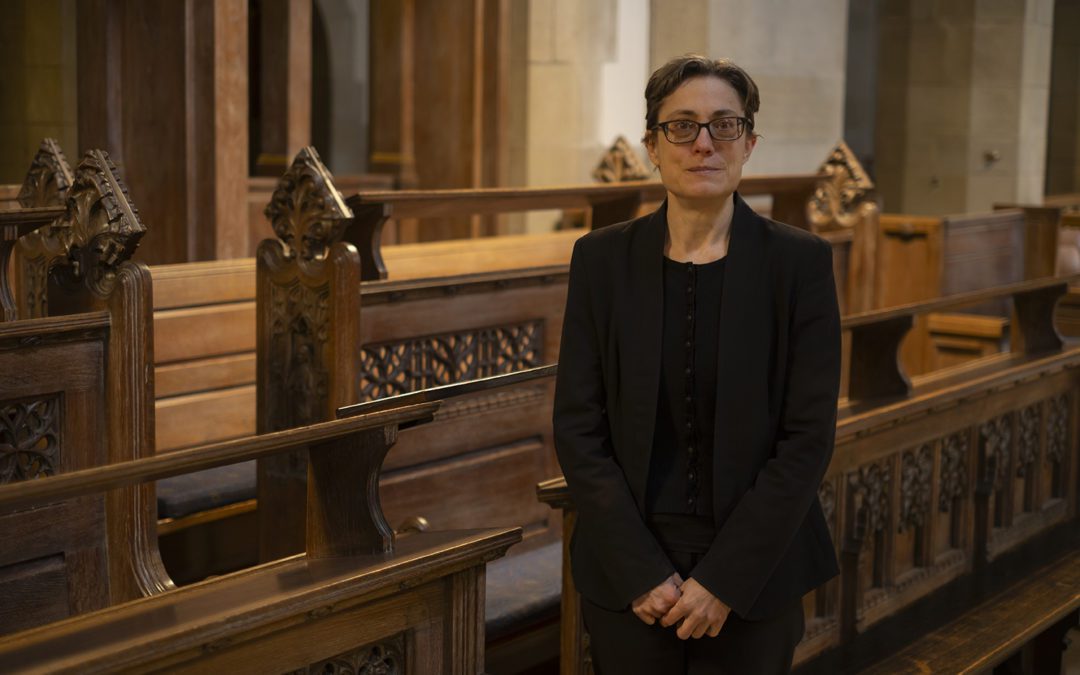On Wednesday 22nd January we welcome Emma Gibbins from Chelmsford Cathedral to Bradford for the second recital of 2025. In this edition of ‘Notes from an Organist’ we discover more about them, and what to expect from their recital, including starting work in Chelmsford; playing a piece written shortly after the execution of Charles I; and playing Welsh language services.
Could you introduce yourself, how you got into music / become an organist and your musical journey to where you are today?
I’m Emma and I’ve been Director of Music at Chelmsford Cathedral since last September. I started out in Oxfordshire, singing in the chapel choir at my school and being enthralled by the range of sounds the organ could make, along with being fascinated by the fact that you had to play notes with your feet! I left school intending to be a chemist and went to Cambridge to study natural sciences, along side being organ scholar at my college, Pembroke. Some years later, after battling through a PhD in Chemical Engineering I came to the realisation that my real vocation was in Church Music, and I haven’t looked back since! After various organ scholarships and living and working in and around London for a few years, I was Director of Music at St George’s Church in Belfast and then at Newport Cathedral in South Wales, before moving to Essex last year.
What can people expect from your recital at Bradford Cathedral?
Quite a range of musical styles and moods including some colourful and exciting transcriptions.
Why do you enjoy playing the organ?
I still enjoy the thing that first attracted me to the instrument: the huge range of colour. And the fact that every instrument is so different and the excitement of exploring and getting to know a new organ.
Do you have a particular favourite piece out of those you are playing?
Definitely Finlandia – it’s so much fun to play and so much fun to register, trying to recreate the vast range of orchestral colour in Sibelius’s original.
This season’s theme is ‘Music in Times of War’. How are you reflecting this in your programme?
Nearly all the pieces in my programme reflect the theme of “Music in Times of War” and, I hope, show how there can still be great creativity, even in times of great pressure.
Tomkins wrote his “Sad Pavan for these distracted times” shortly after the execution of Charles I. It can be viewed as a funeral dirge not only for his king, but also for his life’s work and everything he held dear, that had been destroyed.
The Music for the Royal Fireworks, composed whilst Handel was under contract by George II, was written in 1749 for a fireworks display in London’s Green Park, to celebrate the end of the War of the Austrian Succession. The King explicitly asked for “martial” instruments and drums. We’ll have to make do with an organ transcription in this recital!
“When Jonny comes marching home” is a song from the American Civil War, expressing people’s longing for the return of their friends and relatives who were fighting in the war.
Howells Psalm Prelude, set 1, no. 3, is inspired by Psalm 23, verse 4, “Yea, though I walk through the valley of the shadow death”, which acknowledges the anguish of war. The Psalm verse then goes on to reassure the reader that, even in the darkest times, they are not alone and that peace and reassurance can be found in God’s guidance, surely a comforting message in times of war.
One of Sibelius’s most beloved works is Finlandia, a work depicting the Finnish people overcoming their enemies, which was written in protest against the increasing censorship by the Russian Empire in the late 19th Century. It reflects Finland’s national identity and national pride at a crucial moment in the country’s history. Most of the piece is taken up with rousing and turbulent music evoking the national struggle of the Finnish people. Towards the end, there is a moment of calm, with the serene melody often sung to the words “Be still my soul”, which are a message of profound reassurance for difficult times.
What are your hopes or plans musically for 2025?
As I’m still so new in my role at Chelmsford Cathedral, my main goal is to continue building up the various choirs, developing and building on the work that I have done over the last few months.
You became the Director of Music at Chelmsford Cathedral in September. How have your first few months been?
My first few months in Chelmsford have been a bit of a whirlwind of activity! My priority has been chorister recruitment and I’ve been very busy with publicity, visiting primary schools, leading school assemblies, speaking on local radio, running chorister taster sessions and auditions and generally making connections and building bridges in the Cathedral, Diocese and city. Everyone has been incredibly welcoming, friendly, supportive and encouraging so in a strange sort of way it feels like I’ve been here forever!
You have held musical positions in England, Wales and Ireland – have you found the requirements of the music played differ across the different countries?
Not really, other than having to get to grips with three different translations of the Psalter! In Wales, I had to do the occasional Welsh language service which was a bit of a challenge as I’m not a natural linguist (unless the language happens to be dead…!).
When you left Newport, you gave a gingerbread choir to the choir – was it as tasty as it was well made?
Yes, I gave the gingerbread choristers to the Newport Cathedral choir as a leaving gift! The lady who made them hadn’t ever been asked to make a gingerbread choir before and was, I think, quite bemused by the request. I sent her several photographs of our choristers so she could ice the cassocks, surplices and scapulas accurately. And yes, they were very tasty!
You have been involved in the “Forget me not chorus” for those with dementia – do you find that a rewarding role?
Incredibly so and it really convinced me of the enormous power music has and how much good it can do in people’s lives. I remember sessions with people who were so advanced in their illness that they could no longer communicate or even engage with the world around them. And yet, when I started playing “Daisy daisy give me your answer true” or “The Lord’s my Shepherd”, they would ‘wake up’, sing the entire song, note and word perfectly, and then shut down again at the end. Being able to contribute to their experience of life and enable them to engage with others, albeit briefly, was such a humbling and special part of my week.
In December you posted about the ‘Box of Joy’ – what’s the story behind that?
The ‘Box of Joy’ started in Covid when a friend in Newport and I left a box of home-baked goodies on each other’s doorsteps as a little treat to cheer each other up during the difficult Covid era. The box went back and forth between our doorsteps about 40 times over the last few years and continues to do so, with the help of Royal Mail!
Back in November 2024 you played ‘The Moon Lady’ on the organ, near to Luke Jerram’s moon installation; what was that experience like?
Fabulous! The moon installation is incredible and really inspires you to focus on the wonder of creation and the awe-inspiring magnitude of the universe. I was really excited to be able to include a moon-related piece of organ music (there can’t be many!) in my programme at Blackburn Cathedral: ‘The Moon Lady’ tells a Chinese folk story through music and Chelsea Chen’s atmospheric music, which incorporates Chinese traditional melodies, was really brought to life through being played in the presence of the moon!
Finally, how would you sum up your upcoming recital at Bradford Cathedral?
A varied programme, hopefully, with something for everyone and hopefully thought provoking! And I’m really looking forward to visiting Bradford for the first time and exploring a new instrument.
You can join us on Wednesday 22nd January at 1pm to hear Emma’s organ recital, with an optional £4 buffet lunch beforehand at 12:30pm. You can find out more about them on X or on Instagram.
You can discover more about our organ recital season on our dedicated page.

